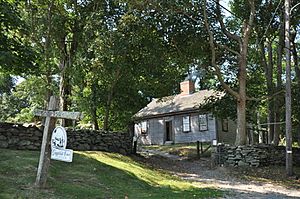Coggeshall Farm Museum facts for kids

Coggeshall Farm Museum
|
|
| Established | 1973 |
|---|---|
| Location | Colt State Park, Bristol, Rhode Island |
| Type | farm museum |
The Coggeshall Farm Museum is a special place in Bristol, Rhode Island, U.S.A. It is a non-profit organization. This means it uses all its money to run the museum, not to make a profit. It is a farm museum located inside Colt State Park.
Contents
What is Coggeshall Farm Museum?
The museum shows what farm life was like in the year 1799. It is set up like a real coastal tenant farm from the 18th century. A tenant farm is a farm where people live and work the land, but they do not own it. They pay rent to the owner.
Experience Life in 1799
The museum covers 48 acres of land. When you visit, you will see "interpreters." These are people dressed in old clothes. They act like people from 1799. They show you how daily tasks were done.
Authentic Reenactments
You can watch or even join in "authentic reenactments." This means they show you exactly how things happened back then. You might see how farmers cared for animals. You could also learn how they grew food. It is like stepping back in time!
History of Coggeshall Farm
The farm has a long and interesting history. It was once home to a family named Coggeshall.
The Coggeshall Family
In the early 1800s, Wilbur and Eliza Coggeshall lived here. They were tenant farmers. Their son, Chandler Coggeshall, grew up to be important. He became a politician. He also helped start what is now the University of Rhode Island in 1888.
From Private Estate to Public Park
Later, the farm became part of a large property called the Colt Estate. In 1965, the State of Rhode Island bought this estate. They wanted to turn it into a state park. The Bristol Historical Society then asked the state for permission. They wanted to save the old farmhouse and make it a museum.
How the Museum Started
In 1968, the Bristol Historical Society signed a lease. They began building other farm buildings. The Coggeshall Farm Museum officially opened in 1973. Its main goal is to teach people today about farm life in New England during the 1700s.

